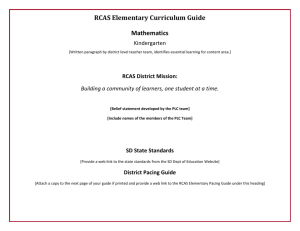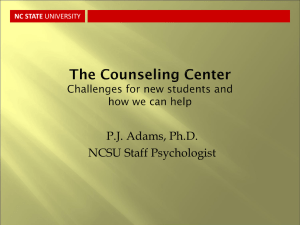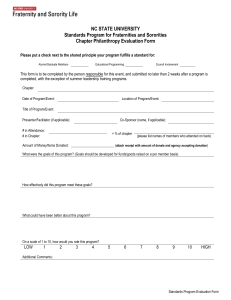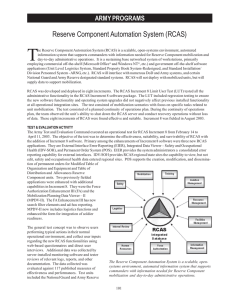Projects - thercas.org
advertisement
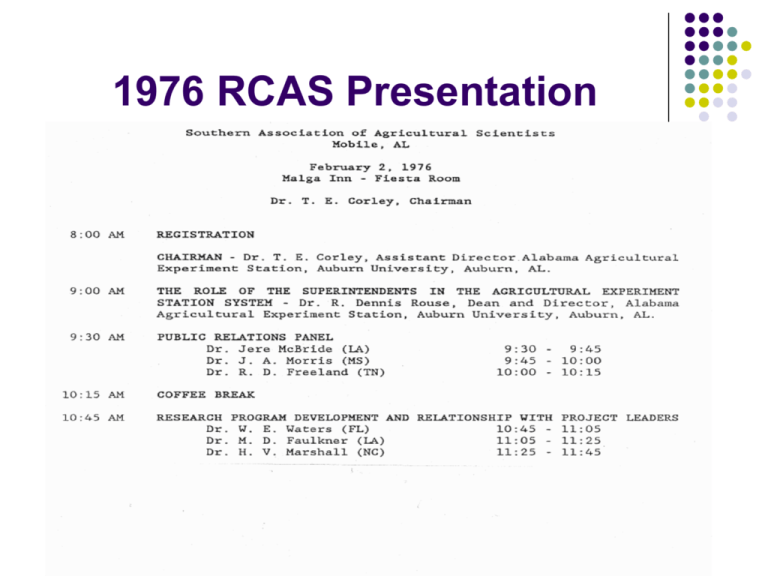
1976 RCAS Presentation 2005 RCAS Proceedings From Dictator to Accommodator, Orchestrator & Educator MHCRS circa 1949 MHCREC circa 1987 Station Employees & Staked Tomatoes Research Diversity Multi- Disciplinary Vegetable Crops Field Day Lifeboat 2007 RCAS Proceedings ‘Workshop on Financial Strategies and Cost Recovery Systems’ Moderated by Jim Beaty, Handouts provided by Arizona Ohio California Perdue Preface FY 2010 - 2011 NC budget - $3.7 billion $ shortfall 1.3 billion $ tax increases to expire 1.6 billon $ federal stimulus to run out State Agencies 5 -15 % cuts Research Stations 25% budget cut at NCSU Stations Station and faculty each pay 50% Direct Cost at both NCSU & NCDA&CS Stations. Budgets FY 2008 – 09 (30% reversion) P.I.’s paid for their own and additional to compensate No temporary labor $ approved from operating the past 2 years. Utilized inmate labor 10+ years. FY 2009-10 No set budget. Written justification required for all requisitions. FY 2010-11 spend only as necessary (no budget set until 1/27/11 with 25% cut) Looking Back FY 2008 – 09 (30% reversion) P.I.’s paid for their own and additional to compensate Where Did Survey Input Come From? CALS/NCSU Administration RCAS Faculty CES Superintendent The Struggle Denny, we are struggling with this very question and appreciate your leadership on a very difficult task. I do not envy you in trying to put together a survey that will address these issues. Survey Goals Partner with faculty and staff to produce quality research. Be fair Evaluate Project impact on overall station Gain support from P.I.’s when funds and labor are unavailable. Assess present use to determine station resources. Grouping Survey Topics How MHCRS and MHCREC can work together more effectively Projects Sustainability Income Labor Grouping Survey Questions How can MHCRS and MHCREC work together more effectively? • • • • What limits research? What are the priorities? What limits expansion? What to do if the situation worsens? Projects O92’s Cost sharing Greenhouse projects Infrastructure Aging Need for equipment storage Equipment acquired from other stations Greenhouse upkeep and maintenance is a major expense. Research land is very limited. New property but limited infrastructure. Diseases and lack of land for rotation are taking a toll on research. Sustainability Defining Sustainability Soil borne diseases Station appearance and maintenance Rotation is beneficial Benefit of Rotation at MHCRS 11 year study 1995 - 2005 Vegetable Rotation Systems (with Tomatoes every 3rd year) vs. Continuous Tomato System Results • • Every tillage and production treatment (plowed vs. conservation treatments and chemical vs. organic management treatments) had greater yields in the rotated location compared to the continuous location. Strong evidence of the importance to rotate vegetable crops. Conservation Tillage for Vegetable Production Greg D. Hoyt. Dept. Soil Science Field Problems Soil borne diseases. • • • Phytophthora Bacterial Wilt Tomato mosaic virus (ToMV) in 2009 Field Sanitation Protocols enacted 2010 Budget Receipts Leasing land vs. maintaining Direct Costs If funding is uncertain Labor Labor pools Inmates If labor is uncertain Survey Questions Emailed December to PI’s and their support staff. Emailed and made hardcopies for station staff. Question 1 Which of the following do you qualify as: Answer 1 _____Mountain Horticultural Crops Research Station (MHCRS) staff: Full time employees who are responsible for managing land, equipment and assist project staff in performing a variety of station operations to support research. _____Project staff: Principal Investigators (PI’s) and technical staff. Question 2 My position is located on the station or off the station? Answer 1. _____Located at MHCRS or Mountain Horticultural Crops Research and Extension Center (MHCREC) _____Campus or other location based. Question 3 Why do you think the ability to perform research at MHCRS is limited? Rate 1 – 5 with 1 the main reason and 5 the least. _____Funds are not available to conduct research and make purchases _____There is not enough help available _____We don’t have the time and resources (like equipment) _____Suitable land is not available _____The quality of research will suffer if project load increases beyond our capabilities. Question 4 Do you work with research projects that are combined with more than one project where the P.I. has more than one project in the same field. Answer 1. _____Yes _____No Question 5 Do you work with projects that are combined with other projects from other departments? e.g. horticulture and plant pathology. Answer 1. _____Yes _____No Question 6 What is the biggest problem with combining projects? Answer 1. _____It is better to keep projects separate from a logistical and practical standpoint. _____Land is available so there is no need to combine. Question 7 If a field has a problem like the soil borne pathogen bacterial wilt and there is no chemical means of control and spread mechanically what should be done? Answer 1. _____Map the infected areas, leave out the infected areas reducing the size of the field and perhaps the project _____Rotate out of the entire field for the recommended 5 years. _____Do nothing about the problem. Question 8 Greenhouse projects are assigned by the Special Facilities Committee and are not submitted as 092’s. Should greenhouse projects be assigned as 092’s in addition to provide better tracking? Answer 1. _____Yes _____No Question 9 What is the best way to approve 092’s? Rate 1-5. Rate 1 as the best way and 5 the least. _____Give priority to projects that are submitted first. _____Give priority to new faculty and graduate students. _____Form a committee to approve _____By lottery _____Handle on a one to one basis. Question 10 What are the stations most pressing needs? Rate 1 – 4. Rate 1 as the most pressing and 4 the least. _____Additional labor _____Develop the infrastructure of the former Southeastern Container property. _____Revising the 092 approval process. _____Doing a whole farm plan for MHCRS to include new and existing land. Question 11 How is sustainability best defined for the immediate short-term future of MHCRS? Rate 1 - 5. Rate 1 as the most important and 5 as the least important. _____Funding projects _____Resource conservation (following recommended crop production practices like rotation) _____Staffing _____Maintenance of facilities _____Expansion of facilities Question 12 How is sustainability best defined for the long-term future of MHCRS? Rate 1-5. Rate 1 as most important and 5 as the least important. _____Funding projects _____Resource conservation _____Staffing _____Maintenance of facilities _____Expansion of facilities Question 13 What should be priority? Answer 1. _____Keeping the station in field day condition at all times _____Performing research. Question 14 What are the most important factors affecting Station upkeep? Rate 1-4. Rate 1 as the most important 4 the least. _____Operating funds. _____Staffing _____Equipment is needed for upkeep. _____Research project workload limitsj time available for upkeep. Question 15 What are the main reasons limiting expansion of MHCRS at present? Rate 1 – 5. Rate 1 as the main reason and 5 the least. _____The number of projects and workload limits expansion. _____Facilities are inadequate _____Operating funds are inadequate. _____Lack of funds for capital projects to improve infrastructure are inadequate. _____Land available for research is inadequate. Question 16 What condition does the majority of the station equipment look like it is in? Answer 1. _____Most equipment is in poor shape. _____Most equipment is in fair shape _____Most equipment is in good shape _____Most equipment is in excellent shape Question 17 If research land is limited what is the best thing to with 092’s as they are received? Answer 1. _____Hold all the 092’s until after the deadline to submit are in and share the land equally and approve all projects. _____Assign projects based on resources the PI is able to provide. _____Give priority to 092’s by date submitted and for project leaders that follow to be okay with land that may not be as desirable. Question 18 How important to your research is developing the infrastructure in order to utilize the former Southeastern Container Property? Answer 1. _____Very important _____Relatively important _____Not important Question 19 MHCRS has generated an average of $5,874 /year in receipts the past 5 years. This amounts to 2.8% of the average operating budget of $207,026 over the past 5 years. Do you think the station can significantly increase receipts for example by 10% to $20,602? Do you think this can be accomplished? Answer 1. ____Yes _____No Question 20 If so, how is this best accomplished? Answer 1. _____Compete more with growers by ways like direct marketing. _____Raise crops to generate income only, like hay. Question 21 Do you think MHCRS should lease the former Southeastern Container property that includes following field sanitation guidelines or for the station to produce hay for sale even if it means increasing operational expenses and workload? Answer 1. _____Lease _____For the station to produce hay Question 22 If the station wants to cost share with a PI and working with a sponsor (e.g. a fertilizer company) for a grant what are the most pressing needs that need to be cost shared. Rate1 - 4 with 1 being the greatest need and 4 the lowest. _____Supplies _____Travel _____Temporary Labor _____Equipment Question 23 If funding and labor is uncertain when submitting a 092, rate 1-4 with 1 the first consideration the PI should have and 4 the last. _____Reduce the size of the PI’s project if funding and labor is uncertain _____Proceed with the project as submitted even though funding and labor is uncertain. _____The PI needs to plan to provide their own additional labor and funding before approving the project. _____Ask the PI to consider moving the project to another station. Question 24 Do you be think it is better for a PI to contribute to a labor pool to hire temporary labor to work on other projects or just their own projects? Answer 1. _____It is better for PI’s to contribute to a labor pool. _____It is better for PI’s to hire labor for their project(s) only. Question 25 Do you approve of using inmate labor? _____Yes _____No Question 26 There is no labor substitute at present if MHCRS’ loses inmates. How would it affect your work if the station lost inmate labor? Answer 1. _____The work I am involved with will suffer. _____It wouldn’t make any difference with my work. _____Other labor sources would be utilized like cost sharing labor if we didn’t have inmates. Question 27 If the current situation (inc. lack of land, labor, funding etc.) does not improve or worsens what can be done to reduce the overall impact on the station? Rate 1-5 with 1 what to do first and 5 what to do last _____Continue as we have been doing until the resources run out. _____Give priority to projects that can fully support their programs. _____Support as much research as possible with P.I’s and Station through cost sharing. _____Researchers will provide a complete protocol to avoid big projects significantly impacting other work of the station. _____For MHCRS to develop a priority order for each resource and what can be done in what order so the P.I. can plan for additional project resources if needed. Blame it on the Computer Survey Monkey limited to 10 questions NCSU Survey Builder Word was underlining text in email Outcome Survey is temporarily on hold • • • • Some questions viewed as leading questions There are no simple answers to the questions and there are pros and cons and consequences. I do not think this is a very valid survey that represents all common answers. I would suggest that you add a comment section to the survey.
